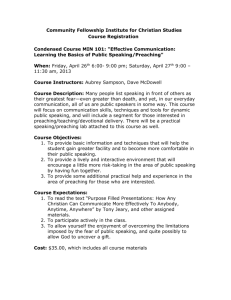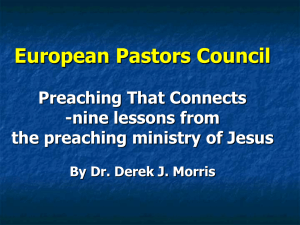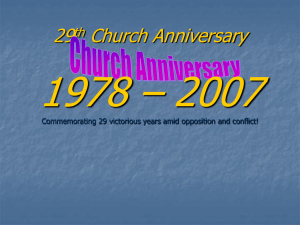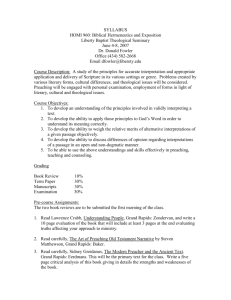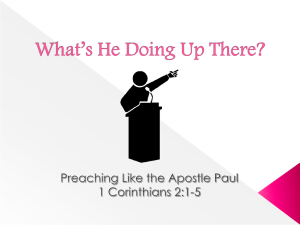Document 11454206
advertisement
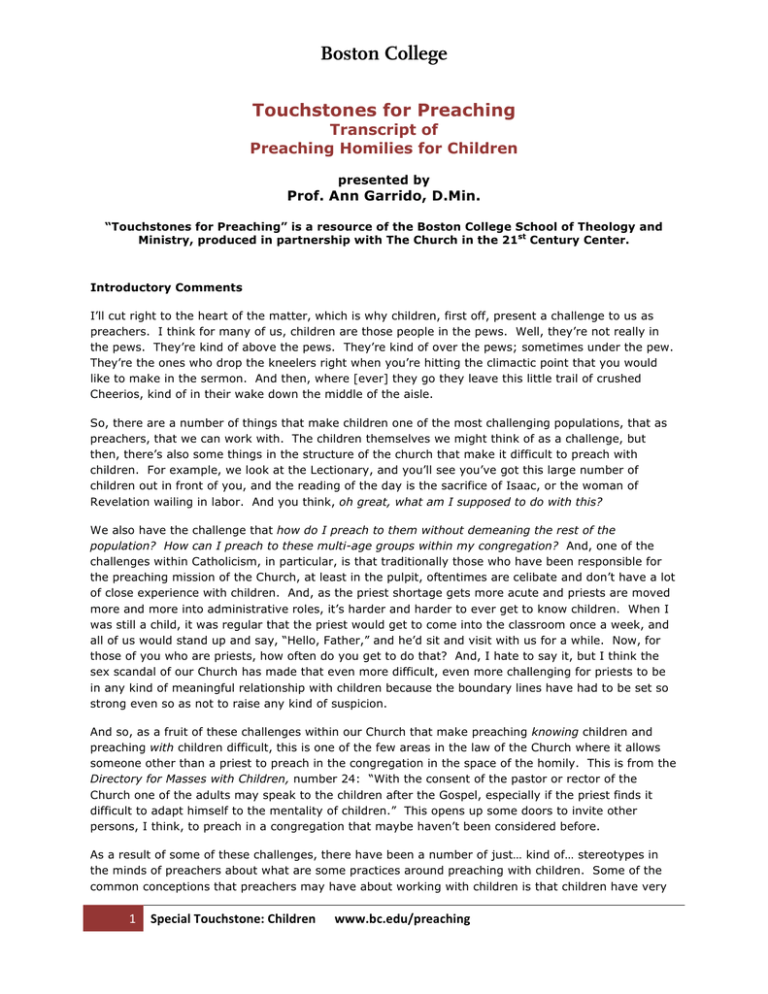
Boston College Touchstones for Preaching Transcript of Preaching Homilies for Children presented by Prof. Ann Garrido, D.Min. “Touchstones for Preaching” is a resource of the Boston College School of Theology and Ministry, produced in partnership with The Church in the 21st Century Center. Introductory Comments I’ll cut right to the heart of the matter, which is why children, first off, present a challenge to us as preachers. I think for many of us, children are those people in the pews. Well, they’re not really in the pews. They’re kind of above the pews. They’re kind of over the pews; sometimes under the pew. They’re the ones who drop the kneelers right when you’re hitting the climactic point that you would like to make in the sermon. And then, where [ever] they go they leave this little trail of crushed Cheerios, kind of in their wake down the middle of the aisle. So, there are a number of things that make children one of the most challenging populations, that as preachers, that we can work with. The children themselves we might think of as a challenge, but then, there’s also some things in the structure of the church that make it difficult to preach with children. For example, we look at the Lectionary, and you’ll see you’ve got this large number of children out in front of you, and the reading of the day is the sacrifice of Isaac, or the woman of Revelation wailing in labor. And you think, oh great, what am I supposed to do with this? We also have the challenge that how do I preach to them without demeaning the rest of the population? How can I preach to these multi-age groups within my congregation? And, one of the challenges within Catholicism, in particular, is that traditionally those who have been responsible for the preaching mission of the Church, at least in the pulpit, oftentimes are celibate and don’t have a lot of close experience with children. And, as the priest shortage gets more acute and priests are moved more and more into administrative roles, it’s harder and harder to ever get to know children. When I was still a child, it was regular that the priest would get to come into the classroom once a week, and all of us would stand up and say, “Hello, Father,” and he’d sit and visit with us for a while. Now, for those of you who are priests, how often do you get to do that? And, I hate to say it, but I think the sex scandal of our Church has made that even more difficult, even more challenging for priests to be in any kind of meaningful relationship with children because the boundary lines have had to be set so strong even so as not to raise any kind of suspicion. And so, as a fruit of these challenges within our Church that make preaching knowing children and preaching with children difficult, this is one of the few areas in the law of the Church where it allows someone other than a priest to preach in the congregation in the space of the homily. This is from the Directory for Masses with Children, number 24: “With the consent of the pastor or rector of the Church one of the adults may speak to the children after the Gospel, especially if the priest finds it difficult to adapt himself to the mentality of children.” This opens up some doors to invite other persons, I think, to preach in a congregation that maybe haven’t been considered before. As a result of some of these challenges, there have been a number of just… kind of… stereotypes in the minds of preachers about what are some practices around preaching with children. Some of the common conceptions that preachers may have about working with children is that children have very 1 Special Touchstone: Children www.bc.edu/preaching Boston College short attention spans. So, you’ve got to make it really, really short. And, because they have such short attention spans, children’s homilies need to be very entertaining. We need to make them laugh a lot in order to engage them. Maybe we want to bring in, like, some extra stuff like puppets or audiovisuals. There is a conception that the deepest mysteries of the faith, they wouldn’t really be capable of understanding those. So, we’ll have to dumb things down a bit, or at least bleach the story, make it more innocuous. And that really, if we just give them the moral point, the point of this is, as my pastor would often say, “Really, it’s just about being nice.” This is how he would oftentimes end. And, I would be, like, “Oh, give me something more than that.” And, that we need to just give them the moral of the story: “Obey your parents and be nice to your brother.” Now, all of these… there’s elements of this that are not bad, but what I want to do today is to talk about a movement that has been observing children very, very deeply, that may have something to say to preachers that could be helpful in helping us understand these little creatures a little bit better. And, maybe would challenge some of the traditional ways that we’ve conceived of preaching to children, help us to think about doing it a little bit different. So, my thought is that children may be capable of more than what we’ve given them credit for. The Catechesis of the Good Shepherd So, let me say just a few words about Catechesis of the Good Shepherd. How many of you have you ever heard the term before—are familiar with it? That’s great. This is a good and growing number. Catechesis of the Good Shepherd was a movement that was founded really, in the, well, it has its roots in Maria Montessori. Maria Montessori lived in the early 1900s. She began as a physician, not as a teacher. And so, her starting point with children was quite different than we might, if we were in the realm of education. In education, the first question that we ask is, what do we want them to know. Maria Montessori, as a scientist by training, started in a different point, which is who are you. And, what she began with was observing children and recognizing that if we observe the children long enough they would teach us what they wanted us to know about them. So she came with this very, very deep knowledge of the child. Now, in the 1950s there was a woman whose name was Sophia Cavaletti, a lay Catholic woman, who had her doctorate in Hebrew Scriptures. And Sophia was interested in the Academy and the teaching and learning of theology, but she had this friend she kept like, being really persistent with her. “Could you please do something about First Communion with my seven-year-old? They’re not enjoying Catechism class at all. They’re not learning anything. Could you do something?” And, she said, “No, really, children are not my thing.” And so they kept hounding her, and finally, she said “Okay.” So, she met with this seven-year-old for the first time, and she said “I didn’t know quite where to begin.” So, we just opened the Bible, and we began to read from the beginning of Genesis. And she said, “Two hours later the child was still hanging in there with me, hanging on every word.” Now what she doesn’t give herself credit for is how well she engages children, how well she asks questions. But what she did recognize was that the Word of God has incredible power. It draws the human ear, even the youngest of human ears. She became very interested in children, and she said, “I need to find out more about them.” So, one of her friends hooked her up with a woman who had studied with Maria Montessori, a woman whose name was Gianna Gobbi. And, Sophia Cavaletti and Gianna Gobbi formed a partnership that lasted for over 50 years, began in Rome, Italy, just in the shadow of the Vatican—Sophia coming with this really deep knowledge of the Scripture, of the liturgy, of the tradition of the Catholic Church; Gianna coming with this really deep knowledge of the child from her Montessori background. And, what they began to do was to work. They created a space that they called an atrium. This was a term that was taken from the very early Church. The atrium in ancient church architecture was the space between the street and the inner body, the sanctuary of the church. The atrium was where the faithful would 2 Special Touchstone: Children www.bc.edu/preaching Boston College gather and settle themselves to get ready to participate in liturgy. It’s also the space in the church where the catechumens were formed. So, they visualized a similar space for children. Not a children’s church because we’re not trying to take them out of the church. But, how do we help children to gather and settle themselves, to prepare themselves in such a way that they can be full, active participants in the liturgy of the Church? So, in this space they began to experiment in a Montessori method, everything very hands-on. And they said we have two great sources: liturgy and Scripture. So, they would take a Scripture story and they would make a physical material that the child could work with. So, for example, [in] the parable of the Good Shepherd, they would carve it out of wood, and one would read the story, and the child could work with the material. And, what they would discover over time was that children if, if the material and the work with the material, if it calmed the child, if it made them peaceful, if it produced in them a kind of joy, then they would keep it in the atrium. And, if it didn’t produce that fruit, then it would go into the reject closet. And over a long period of time working with children, certain themes began to pop up over and over again that seemed to appeal deeply to children in this age group, or to children in this age group, or to people in this age group. And so, a body of wisdom about who children are and what themes most appeal to them began to emerge. They invited other people to begin experimenting with children in similar atria around the globe. And, the movement kind of took off from there. Seven Characteristics of Children [Visual] Seven Characteristics of Children 1. 2. 3. 4. 5. 6. 7. Children are not blank slates Children are drawn to the most essential. Children are most interested in what is real. Children are filled with wonder and awe. Children possess absorbent minds. Beauty evokes reverence in children. Children are small in a big world. So, what have we learned from this observation of children? I want to go down, and I’m going to talk about seven characteristics of children, and I’ll particularly focus on children in the age range of three to nine, but you can ask questions about other ages, too, if you want to. 1. The first one is that children are not blank slates. What do I mean by this? Oftentimes, our cultural conception of children is that they’re tabula rasa, that they have no information about God, and so that we’re going to pour in some information. We need to pour in knowledge about that. The observation of catechists is that actually children, even when they’re preverbal, have often a very deep and profound relationship with God that they simply haven’t found words yet to express. But, similar to RCIA where you recognize that this person who has come to become an inquirer in RCIA, that they have had a journey that precedes them coming to you, that there’s been… the Holy Spirit’s already been active inside of their life, and that’s what’s drawn them to the doorstep of your parish, right? And, that you have to acknowledge God’s already been on this ground before we ever stepped there. So recognizing and helping them to name where the grace already has existed. Children very similarly. 3 Special Touchstone: Children www.bc.edu/preaching Boston College One of Montessori’s deepest beliefs was that every child had within them what she referred to as the inner teacher—a kind of drive within the child that leads them in this direction or that direction toward what their greatest need is. That when they most deeply desire something, that when they need to learn something, it’s met by a deep desire within the human person. So for example, none of us have taught children how to speak our language, but there’s a drive within children to master language and that there’s an age at which it’s very, very easy for them to master language. And so, if we can introduce at that age level what their own deepest drive is toward, the learning happens very easily. For example, young children before the age of five learn an average of nine words a day. Can you imagine? Nine words a day, and it’s easy for them. But if a child is not exposed… anything that we’re not exposed to orally by the age of 10 months—a sound, our open window for being able to create that sound—begins to close. So I will never be able to speak Hausa, or the click languages of Africa, because I did not hear those sounds early enough, and I will never be able to replicate them. So, it’s finding that open window in which both the drive and the need to master the task are there. So, every child has within them this inner teacher who’s driving them toward the good, and in Catholicism, or Christianity, we call that the Holy Spirit. But every child, before they’ve ever, we’ve taught them anything, they have the Holy Spirit within them that has led them. And so oftentimes, even when we do presentations, I’ll begin by saying, “You already know that,” and they nod their heads like, “Yes, I already know that.” 2. A second point is that children are drawn to what is most essential. Most essential. When children are presented something that they consider to be essential, they grow calm and they become happy, settled happy, not running around in a frenzied circle happy. Cavaletti has said, “When a child’s physical needs are met, it’ll manifest itself by growth in height and weight,” changes in growth and height and weight. When a child’s spiritual needs are met, it manifests itself in joy. They grow a peaceful kind of calm. So when they’re fed what is most essential, this is the fruit of it. When you see children being incredibly restless, oftentimes it’s because what they’re being fed is not essential, not what they consider essential. So, we have a line in catechesis that says, “We must give children rich food and not too much of it.” But we’ll talk about that again because that has a lot of potential for preaching. We must give children rich food, and not too much of it. 3. So again, that begs the question, what is essential? One of the things we know that children find to be most essential in their lives is that they wish to be oriented to reality. This is a phrase that comes right from Montessori. A common conception is that children are really interested in fantasy. They want to imagine fantastical things and that we have to make up fantastical stories for them. What Montessori’s insight was, was that actually children are most interested in things that are real. They really would like to be able to function in the world and to be able to do things for themselves. How often do you hear, like a two-year-old say, “I want to do it myself.” Right? So, they want to be able to do things themselves. They need to know how the world ticks, how it works in order to do that. So… so oftentimes we buy them these great toys for Christmas, but we find them playing in the box, or we find them—as my son spent half of his early childhood—wrapped up in the telephone cord having conversations on the telephone. They want, how desperately they want, to get on that computer. Have you seen this? How desperately they want the cellphone. Because they want to be able to function in the way that they see adults function in the world. So, they’re actually very, very interested in reality. It becomes a joke in many a Montessori school. My co-worker and I often will speak of adults and say, “That one needs to be oriented to reality,” with each other. But, each of us has a deep desire to be oriented to what is real. One of the things that they treasure deeply in being oriented to reality is they need to learn how to use language. Acquisition of language is very important for orientation to reality. So, children are very interested in acquiring the language that will help them to get what they need in the world. They 4 Special Touchstone: Children www.bc.edu/preaching Boston College love big words. They love new words. They sometimes like to make up words, in order to, because they love the sound of it. They love what we would call “practical life,” being able to do tasks. Like how do I wash my hands? How do I dress myself? How do I learn how to… can I learn how something… to do something in the kitchen because I see you in the kitchen all of the time? But, the deepest level of reality that children need to be oriented into is really… religion is about orientation to reality, is it not? That one of the fundamental needs of children is to know, not just at the surface level how do I function, but what in the house, but what is it that’s holding up the house? What is the support structure for all that is in the world? That’s the deepest reality that there is. God is really the ultimate reality. So children are going to have a deep, deep desire, then, inherently for God, because in order to be oriented to your reality there’s no way to do that without God. 4. A fourth characteristic of children is that children are filled with wonder and awe. The way that when they’re in the presence of what’s essential and what’s real, children are prone to wonder and awe. Wonder is a magnificent thing. Wonder doesn’t push, make you do something; wonder pulls you toward it. Wonder, like… you can move like… like a magnet when it moves back, and you just… you find yourself drawn to it, wanting to get closer and closer to it. Wonder draws a person in. And wonder manifests itself largely by questions… by questions. So we want to find out what is it that children are asking? What is it that they’re wondering about, that they’re in awe of? And, we would say that the earliest form of prayer that children manifest is not petition; but the very first prayer of children tends to be praise and – wow – thank you. We know that they don’t even really develop a social consciousness, an awareness of others so much until at least the age of… around the age of six. Younger than the age of six, they are the center of their own world. And they, even their play is more side-by-side with each other, rather than interactive; they’re not terribly aware of the needs of others yet. So around the age of six they begin to develop a capacity for petition, for moral questioning. But before that age their… that doesn’t mean that their prayer is any less valuable. Their first prayer tends to be thank you. Their first prayer tends to be praise. I remember when my son was very, very young and I was just studying about children for the first time, and I had heard this and I thought, “Huh, I’ve never asked him if he wanted to pray with me.” He was one. He was just… he knew, he knew how to say cookie and mom. That was about it. And, I said, “Micah, is there anything you’d like to say to God tonight?” And, he said “Alleluia.” Isn’t that something? And when I reflected on that, I thought “when you look at the way children develop language for the first time in their very beginning thing, what do you first hear them say?” “Abba, Abba, Abba, Abba, Abba, Abba.” And I thought, “Isn’t that interesting. That’s the name that Jesus gives to God.” And then immediately after, the next set of letters that they begin to develop, hallel, hallel, hallel, hallel, hallel, which is the Hebrew word for “praise God.” And, you begin to wonder, “Did we create these words, or were our lips actually created for these words? Were our lips created for praise? So that earliest form that rolls off of children’s mouths most naturally is praise and thanksgiving. 5. Fifth characteristic, children possess absorbent minds. This tells us something about how children learn. Children, especially before the age of six but even well long afterwards, do not primarily learn by sitting down and reading something and absorbing it, or hearing a lecture and taking notes on it. The primary way in which children learn is like, via osmosis. It comes in through the body cells. We don’t entirely know how that works. But they absorb the culture, the environment around them. So for example, again, this one day Micah was walking through the house with my hair dryer going, “Bang-bang, bang-bang.” Now, I don’t have a gun in my house. I don’t even… I thought we had banned all cartoons from the house, violent cartoons from the house. Somehow, though, he learned that. How? I don’t know. But, he absorbed it from the larger culture. And, to the same degree, one time I found him walking through the house with a book over his head, you know, singing 5 Special Touchstone: Children www.bc.edu/preaching Boston College alleluia. And, where did he learn that? No one said this is what we do at Church, but he absorbed it by being in that environment. So the primary way in which children learn is through absorption. If the child has an inner teacher that drives them to want to learn and to know, the environment is the outer teacher, if you will. And so the environment is going to be much more important than the words that are going to be used. 6. A sixth characteristic, beauty evokes reverence in children. I don’t think before I began to live with children in the atrium that I… that I understood the role that beauty plays in children’s lives. Oftentimes, at least in my own upbringing, if you have children you bring out the plastic sippy cups and the… like, plastic plates, right? Because children, you know, they’re going to—by the end of the meal if you’re outside—they’re going to be using their plates as Frisbees. Right? They’re sailing across the yard. What I didn’t understand is it’s not that children naturally would do those things with your plates. It’s that, the flip of it, that if you give them those, then that’s what they would use them for because they’re not worthy. They don’t see them as valuable. But if you give children something very, very beautiful, they’re actually capable of treating things with great care, with great reverence. Often in the atrium parents walk in and they’ll say, “Oh, my child will never make it here” because we have a lot of glass objects. But the irony is, is that we only break one about once every two years because the amount of care that they will show if they are in the presence of something that is beautiful. They’ll treat it with great reverence. The same is true with language. If they know that a word is special, they’ll use it with great care. One of the four-year-olds one time, she came to [the] atrium and she said, “I was standing in the grocery store and I decided I would sing, ‘O Come, O Come Emmanuel.’” Then she said, “But they just did not understand.” Like for her, this was the proclamation of a beautiful word that she wanted to share. So they like a few well-chosen words. And in reality, they will care for things that are beautiful, and they break things that they think they’re cheap. That includes language as well. 7. This is the last characteristic of children that I want to talk about, that children are small. Now, I know you say, “Ann, oh, no, duh. Brilliant.” But, we oftentimes don’t think about the… about the impact of this. Children are very small in quite a big world. So a couple of years ago I was in my parents’ cooling cellar. Now, when I was a kid—I’m the oldest of eight, and my brother, my sister, and I are all within two years of each other in birth—and we used to have this huge, gigantic stuffed lion that we would ride around the living room. All three of us would fit on its back and we would go on safari in it. And, a couple of years ago I found this stuffed lion in my parents’ cellar and the thing’s about this big, and I’m still trying to figure out how were all three of us on that lion. But when I was a child, it was a great, huge lion. So children live in a world in which they are small and everything else around them is quite large, and this affects the way that they see the world. That everyone is bigger and more powerful than themselves, but that what they recognize is that there is a power inside of the tiny that people just aren’t able to see, and that they’re drawn to characters in stories, characters in society that are too small for anyone else to notice, but they’re also the ones that are the most important to God. And this is what children recognize time and time again, that they have pointed out to us that God has a preferential option for the small. And that if we begin to read the Bible through their eyes, that over and over again we will see that God keeps choosing the smallest ones of the earth, that God could have come anywhere in the world, but God chose Israel, like this little tiny dot on a map. And in all of Israel God could have come, but no, God chose Bethlehem, so tiny, and of anywhere in Bethlehem God could have come, no God chose the stall out back. So, what they point out to us is that God chooses consistently the small, and that if we begin to read the Scriptures with children, we begin to see that over and over again they keep pulling out points of Scripture that we may have overlooked or 6 Special Touchstone: Children www.bc.edu/preaching Boston College missed because they’re always drawn to the tiny character, oftentimes the one that got forgotten. They will want to emphasize that there is tremendous power and energy inside of the tiny. Three Core Mysteries: Relationship, Life and Death, Time So let me say then, a few words about core questions and mysteries of children, and then we’ll do some application. So what we have discovered about children is that there are three core sets of questions that they consider utterly essential, that they spend a lot of time wondering about. These are the places of opening to draw them in. The first great set of questions—or I could call it the first great mystery—is the mystery of relationship. Who am I? Who are you? Who are you, God, and who am I in light of that? What does it mean for us to be in relationship with each other? What are the rules of being in relationship? And, how do we celebrate this relationship that we have with each other? Michael Himes, who is a theologian here at Boston College, has a line that I love where he says “What’s true always and everywhere must be celebrated sometime, somewhere.” Right? “What’s true always and everywhere must be celebrated sometime, somewhere.” So if we’re in relationship all of the time, what are those moments where we celebrate our relationship? How do we celebrate relationship? This mystery, we might say, is the deepest and the most essential one of all of humankind, and hence the younger the child, the more essential they are. And so this is the very first set of questions, the very first need that the human being ever has. The second great mystery is the mystery of life and death. What does it mean to be alive? How did I come to be alive? What has happened to my grandmother, who I know she was here, but you’ve said she’s not ever coming back again? Will I die? And we know these questions begin to emerge particularly around the age of four. It seems to be an awareness of death manifests itself very young. I distinctly remember all of [a] sudden my son just sitting one night when he was four and he just started crying, and I don’t remember what he said exactly, but whatever he did say let me know just very clearly that all of a sudden it had really struck him that there was such a thing as death and it was final. Sophia says that the… Cavaletti says that the question she hears children most ask is “What is life?” And, I remember thinking to myself, yeah, like really? They sit and ask, “What is life?” And, this one night I went upstairs and Micah was lying on his bed. I had said,“Go upstairs and get your clothes off and get in bed.” And I came upstairs and he was just lying on his bed, all of his clothes on. And I said “What are you thinking about?” and he just said, “What is life?” It’s true. I mean it was. What is life? What is life? What does it mean to be alive? And the last great mystery, they say, is the mystery of time. This one begins to strike the child’s fancy around the age of six in a new way. Before that, there’s yesterday, today, and tomorrow, and there’s not a whole lot beyond those. But around the age of six the mind opens up to huge new expanses of time, and it begins to be… and also this whole new social character develops, and so it begins to be not just the question of where did I come from, but where did the world come from? And, how long has the world been going on? And, what was before the beginning of the world? And, what was before the beginning of God? And, does… where is it heading? Where are we going? And, will the world ever have an end? So, these are the three great mysteries we would say that children have said; this is the heart of the matter. This is what’s essential that we reflect on. And Cavaletti says if children can in some way make peace with these three great mysteries, they’ll be able to live into the fullness of life. That line from John 10: “I’ve come that you may have life and have it in the fullness.” And I very much know 7 Special Touchstone: Children www.bc.edu/preaching Boston College as an adult, and I say, “Live into these mysteries because it’s not like they’re going to be solved.” Right? Any of you guys figured out the mystery of time? You got that under control? Anybody understand what it means to be in relationship fully? Anybody got it figured out what’s going on on the other side of death? So these are the core mysteries we say of the three to nine child, but really they’re the core mysteries of humankind that are going to remain with us all the way through our life. And so back to this question that was asked in the beginning. When we can preach to those core mysteries, we will be hitting—even though we may be speaking directly to children—we will be hitting probably everybody in that congregation because there’s nobody that’s not wondering about these things. Recommendations for Preaching to Children So what I want to do next is then leap into… If this is who children are, how do we make some applications as preachers with children? What are some recommendations for preaching with children? This point comes from an Episcopal priest who I interviewed several years ago who was really great with preaching with children. And she is at Harvard Divinity School, and she said during one of her Divinity School lectures in preaching, one of the seminarians had asked, “So, am I supposed to have three points in my homily, or should I have five points in my homily?” And the professor said, “I don’t really care as long as you have one.” And I think this is a great line for two reasons. First, it means your homily with children must have a point. It should be substantive. Preaching with children is not the time to share your great joke. It’s not the time for an entertaining story. It really is—no matter how old that child is—it’s the time for the proclamation of the Gospel. So preaching should have a point. Children really are capable of understanding something, so we shouldn’t just skip by that moment of the Mass and say, “Oh, they’re not going to get it anyway. I don’t really need to prepare for preaching for them.” So the preaching should have a point. But on the other hand, preaching with children really can only have one point. You’re not going to be able to make multiple points in a homily with children. You should be able to have one point, and you should be able to state it in 20 words or less. So think to yourself in advance if nothing else happens, “This is what I want to… this is what I want to say. This is what I want to get across, and I should be able to say it in 20 words or less.” It doesn’t mean your homily is 20 words or less. You can go up to 40, but you can… your… your… you should be able to state the aim of what you wish to communicate in 20 words or less. You’re not going to be able to have multiple points in preaching with children. So, always be asking yourself, “Could I be more essential? Could I be more simple in what I am trying to get across? Could I use fewer words?” And then, what you want to convey with your one point or your just one image, is you want to get across, “I am about to say something very, very important. So I want you to prepare to listen up, to hear… this is what Jesus wants you to hear today, and then just as short and as simple as I can make it be.” But just one. So, this returns to the point we were speaking about just a moment ago. Preach the great mysteries with wonder. If in your homily you can start with one of those great questions that the human person is… is wondering about, that automatically draws magnetically in because it feeds our deepest human hunger. So connect one of their essential questions to the reading of the day. For example, you know I could start a homily, “Sometimes we wonder about death. What is it that happens after we die? And, in today’s Gospel we meet someone who is asking a similar question and this is what Jesus said…” Or, it could be something like, “In a world that’s this big with so many people, we might really wonder, is it possible that God knows me by name? Is it possible that God knows who I am? Today’s 8 Special Touchstone: Children www.bc.edu/preaching Boston College Gospel gives us a clue about that question.” So it’s just starting, linking it directly into the deepest questions. What I would really emphasize here is, do not feel compelled as if you must have an answer to this question, because even Scripture itself, any one reading, is going to give us a hint—a clue that we’re going to continue to ponder for the remainder of our lives. But it’s not like anybody has figured this out. These are deep ongoing questions; and don’t feel as if you need to tie them all up with a neat bow and have it solved. No one has solved it because the purpose of mysteries is not solving; the purpose of a mystery is to draw us into relationship. And the bizarreness of a mystery is that the more we know about it, the more we don’t know about it. So I’ve been married now for almost 20 years, and I would say I understand less about my husband than I did the day that I married him. And, that’s not… it doesn’t mean that I don’t know him. It means I know him even more, and I realize all the things that I don’t know, or that I don’t understand. So the purpose of mystery is to draw, to make us curious so that we’ll continue to be drawn into relationship. And ultimately, the greatest mystery of all is God. There’s that great line from Augustine where he says, and I won’t be able to do it in Latin, but the English translation is, “If you think you have understood God, then what you have understood is not God.” God is Infinite Mystery. And the reason God gives us questions? It’s because it makes us keep drawing us into relationship with God. So I think it’s perfectly fine to end… in fact, I think it’s ideal many times to end a homily on, “This is a very big question. This is something that we’re going to think about for a long time.” And, just let them go on wondering. A third point is focus on the kerygmatic over the paraenetic. Now, let me explain what we mean by that. In Scripture we can say all of Scripture has two parts to it. The proclamation of the Good News—the announcement of the gift, what God has done for humanity, the relationship that God wants to be in with humanity to the point of sending Jesus Christ—and this is what we call the kerygma, the Good News. The paraenesis is a Greek term that means moral exhortation, like what do we do in response to the Good News. So this is the Good News and then, when we receive a great gift oftentimes because gift… again the purpose of gift is to draw us into relationship. I give you a gift; it’s free. But oftentimes you open it, you enjoy it, and sometimes you want to give a gift in response, like, “How do I respond back?” And in that dynamic of giving gift and receiving gift is how relationships develop. So kerygma is the announcement of the gift. It’s what God does for us. Paraenesis is what we… the way that the Gospels tell us this is how to respond. If you want to respond to the gift that God has given, this is the way of behaving; this is the way to live your life. Oftentimes, we start preaching with paraenesis, with small children especially. “Obey your parents. Be kind to your brother and sister. Do what’s right. Do your homework.” But, we’ve never first announced the gift. And, Sophia Cavaletti says, with the youngest children before the age of six, a hundred percent of catechesis should just be kerygma; just the receiving and the opening and the enjoyment of the gift. And truly, if you’re a parent, you know that this is what’s most important. When you give a Christmas present to the child, what do you want to see happen more than anything else, is you want to see them open the gift and love the gift. You don’t even care if they say, “Thank you,” do you? What you most want to see is that they love the gift. And it’s the same way… I remember when I was pregnant with Micah there was this woman I taught with and she had four really kind of crazy children. And she was the one that was so excited that I was pregnant, much more excited than I myself was at that moment in time. And she was like, “This is great, you’re pregnant.” But then every day she’d come to school, and she’d be like, “Ugh, this one, he flushed my watch down the toilet. You know this one over here, he’s in trouble, he’s got F’s and I don’t know what to do.” And finally I said to her, “Why are you so excited that I’m having a 9 Special Touchstone: Children www.bc.edu/preaching Boston College child?” Like, is there anything good about this at all? And she said, “Ah, yes.” She said, “Sometimes they just look at you and they smile.” And I thought, “That is not going to cut it.” I thought, “That is not going to do it.” And then as soon as my son was born, he could cry all night long, and really all he had to do was look at me and smile. And I’d be like, “Oh, are you not the most wonderful creature ever? Are you not the most beautiful thing that ever existed?” And so every once in a while when I'm outside and I know I’ve just done something really bad… you know, you just look at the sky and you go… you know just smile at God. That is all that God really really wants. But as we grow and as we mature we begin to say, “How can I respond more fully to the goodness of all that I have received in my life? How do I say thank you? How do I make my life a blazing thank you to God?” And when those questions begin to arise, that’s when it’s appropriate to begin to do paraenesis. That’s when it’s appropriate to begin to preach the moral homily. But first it must be grounded in the proclamation of the Good News. So how do I preach in such a way that it helps the child to fall in love with God? Because when we love someone, we want to do what’s right by them. So Father Delmazzio Mongillo, who is a Dominican who used to teach at the Angelicum and was a close friend of Cavaletti’s, he said, “We want the moral actions of children to be like fruit of the vine, not ornaments hung on a Christmas tree.” Isn’t that a great image? Fruit of the vine, like it grows out of the relationship that they have with God, rather than a separate… like a decoration that goes on the outside. We want an organic relationship between who they are and what they do. So as much as possible we want to preach the Good News and help children to fall in love with God, and then help give them clues of how to show their love for God. A great question, I think, to ask myself after a homily is, “Do you love God more after hearing that, or less?” And, sometimes I’ve had seminarians say, “But you have to tell them the truth about this.” I say, “Yes, of course, you have to speak to them the truth. And you must speak the truth in such a way that after you are done speaking it, they will love God more rather than less.” So you can say a very hard truth, but you have to show them why that’s the most loving thing that God could do for you. My favorite professor in graduate school, he gave the most phenomenal homily on why hell is the greatest love of God. (We can talk about that later.) But that…but he… I mean, I was deeply persuaded by it, that hell, the existence of hell is the greatest love of God. But that was a very… and so I… He told me the truth of hell. But I am in love with that God who can allow that radical of freedom that we could… that the nature of love is that I could always have the option of rejecting you, even forever. That’s how free God makes us. Now that makes me fall in love with that God, rather than many other homilies that one could hear on hell. So how do I preach in that kind of way? Ok, a fourth point, consider the nonverbals. Because we said that children are very, very impacted by the environment around them, what who you are when you preach with children is going to be just as important, if not more important, than what you say. So how you stand, your posture with them, what you convey, how you dress—all of these things will have a tremendous... They’ll be picking those up at the same time that you’re picking your words up. One time I thought I had given this really quite brilliant and profound sermon, if I may say so myself, and the girl in the front row, Annalee, said, “Miss, why are your fingernails pink?” So it may be like, even how do I even simplify my figure, that there’s nothing about me that’s distracting from the message that I am trying to speak. One of… and especially, how do I convey with my body that what I am saying makes me happy? How did I convey if I’m preaching about, “You must believe in Jesus Christ, he is the Savior of the world, he is the only one who will bring you joy.” That my message is not in har… my message is not in harmony with my body expression. So if I cannot convey to… if I’m not a happy person, I mean why would you want to go join a bunch of people who are dour? If I’m not at peace myself, how am I 10 Special Touchstone: Children www.bc.edu/preaching Boston College supposed to persuade you that the Gospel of Jesus Christ is going to lead you to peace? So we must be very careful on being transparent ourselves. One of my fears about introducing… I’ve seen preachers use puppets or other characters in preaching very effectively. There’s a priest in St. Louis who does it beautifully. But one of my fears about doing that, of creating like entertainment, blending preaching and entertainment, is that… Is that consonant with the message that I intend long-range for the child to receive? Which is that Mass is supposed to be entertaining—when in the long run I don’t think that’s what we want to communicate. That this is the space where we come to enjoy the gifts of God and give thanks for these gifts, and that if I wish them to demonstrate reverence in this space for the remainder of their lives, I probably don’t want to introduce it as the space where we come to have fun and laugh. The first time when they were… when my book was being published, the editor who I worked with called and she said, “I have bad news.” She said, “On the cover of the book there’s a bunch of children.” Well first she said, “The bad news is the cover is mustard yellow because it’s called Mustard Seed Preaching.” (You must know I have a very strong aversion to mustard, so every time I would have seen the book I would have wanted to throw up.) And so then, the other thing she said is, “It’s children laughing outrageously as if the priest has just said a great joke.” And, I was like, they had… I’m like, “Whoever designed the cover at that point hadn’t read the book itself, which is about a very different point—that preaching is not about entertainment.” So I just wouldn’t think about what is… what do you… How is there supposed to be a harmony between the method of your preaching and the content of your preaching? And then, the last point I want to make methodologically is to read with the eyes of the small. So a great practice if you’re going to be preaching with children is to gather a group of children together in advance and say, “Hey, let’s read this Scripture story together. I want to hear what you hear. Tell me what you think is most important in this story.” And just listening with the children, or if it’s hard to get access, listening to, like, the catechists of your parish and their experiences with children. To listen to what is it that would children hear in this story that they think is most important. Because we’ll begin to see something of that God’s M.O., that modus operandi of God, the preferential option that God has for the small. One of the liberation theologians, Jon Sobrino, makes a really good point. He says, “If we really want to understand the Gospel, we must listen to the Gospel with the people for whom it was first announced, the anawim of Palestine.” And that if we sit by their side and listen to it with them and hear how they hear it, that’s the original audience for the Scripture. That’s the original audience for the Gospel of Jesus Christ, and so then, we will understand better what the Gospel means because we’ll be hearing it with the people for whom it was meant, for whom it was spoken. And, the words will make new sense to us by sitting in that space. [Visual] Preaching Homilies for Children 1. 2. 3. 4. 5. Make one point. Preach great mysteries with wonder. Focus on kerygmatic. Consider the nonverbals. Read with eyes of the small. Now, spend a few moments reflecting on the questions at the bottom of the page. 11 Special Touchstone: Children www.bc.edu/preaching Boston College [Questions on web page] What characteristic of children most challenges you when you think about preaching to children? Why? What recommendation for preaching to children was most important for you? Why? 12 Special Touchstone: Children www.bc.edu/preaching
